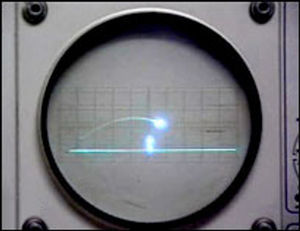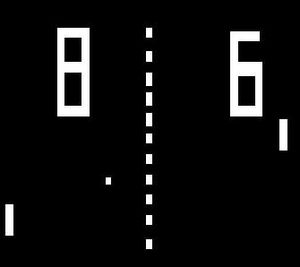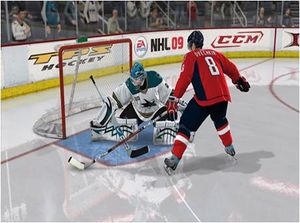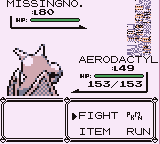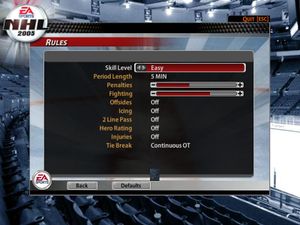F08 CPSC203 T08 GROUP 5
Contents
Our Group
Team Name
- Team Xtreme XD
Team Members
- Tanya Lu
- Kevin Numerow
- Imran Sumar
- Richard Zwarych
Initial Project Statement
The evolution of graphics has come a long ways in the gaming industry in recent years, but how far has it actually gone? Can an individual distinguish the difference between what's reality and what's not and to what extent will the player feel the utmost participation in the game? Most virtual games, nowadays, are designed so that they are made to look and feel as realistic as possible, especially in the area of virtual sports.
In this section, we will focus on the issues of trying to simulate an actual sports player and programming all the rules of a sport into a game. These issues must be taken into consideration when creating a virtual sports game. To better your understanding of these issues, we will use the sport of hockey to demonstrate the various problems of creating a virtual sports game.
Introduction
Virtual games have become the norm for people of all ages, including seniors, in today’s society. Most of which, are designed with the player in mind (called HCI – Human Computer Interaction), especially in the area of virtual sports. These games are created so that the player feels as though they are participating in the game, but without actually having set foot in the real life event.
Back then, games were played without the use of a remote or keyboard, and it was harder for players to cheat. Nowadays, with the invention of the internet, individuals are able to uncover cheat codes for the game that they are currently playing with just a click of a button. As technology advances, video game designers must deal with the problem of making it harder to double-cross the system. The graphics must also be made to look and feel as realistic as possible in order to attract the attention of buyers. And most importantly, such games must attempt to accurately simulate an actual sports player and include the complex set of rules that run the entire game.
History
Virtual games have been in existence for many years now. But where did it all begin?
Nobody knows for certain as to who invented the first video game. But the earliest one may have been created by an American physicist named William Higinbotham in 1958, at the Brookhaven National Laboratory (BNL) in Upton, New York. Higinbotham’s “Tennis for Two” was played on an analog computer, which was connected to an oscilloscope (oscilloscopes are most commonly used in hospitals to measure the heartbeats of patients). This game may have sparked the beginning of a new generation in virtual gaming. At this point in time, computer graphics were very simplistic and boring to look at. Images and characters were not realistically portrayed as they are today.
Since then, computer graphics in video games have evolved drastically from the most simplistic to the most graphically intriguing of all. Below is a timeline of the evolution of video games:
1960s
1961 – The first interactive game, called “Spacewar”, is created by students at the Massachusetts Institute of Technology
1966 – “Chase”, the first interactive video game to be played on a standard television set is created by Ralph Baer
1970s (“The Golden Age of Arcade Games”)
During this period, game development was divided into several different areas, such as handheld games and arcade games.
1972 – “PONG” is created by Atari.
1978 – Coloured video games become popular
1980s
End of the “Golden Age of Arcade Games”
1980 – “Battlezone”, the first three-dimensional (3D) arcade game is created by Atari
1981 – “3D Monster Maze”, the first 3D game for home computers is created by Malcolm Evans
1983 – “Dragons Lair”, first animated video game is created
1990s
Simulation games begin to evolve.
1998 – Nintendo releases the Game Boy Color
2000s
2000 – “The Sims”
2007 – “Halo” is released by Microsoft
2008 – "NHL '09" is released by EA Games
How Easy Is It To Cheat? (Reality vs. Video Games)
Intoduction
Cheating refers to the player’s ability to create an unfair advantage through the means of cheat codes or glitches that can be found throughout the game. The evolution of cheating is a compliment to the evolution of graphics, where it's evolution has been closely following that of gaming.
History
Cheat codes have been around ever since the beginning of gaming, where originally players were simply able to reprogram a portion of the game before launching it resulting in the desired outcome. Whereas modern day cheating is a much more complicated process, often involving complex button combination's or long cheat codes. An earlier example of this would be Contra. Contra for the NES was an action adventure game, where if the right sequence of buttons were pushed (up, up, down, down, left, right, left, right, B, A) your lives would be boosted from 3 to 30. These cheat codes dramatically decrease the difficulty of games which is why many players choose not to use them. In 1978 Warren Robinett, an Atari game designer implemented the first easter egg (a hidden surprise found in video games), where he used a single gray pixel as a portal to a secret room where his name was displayed in bright colors. Easter eggs are essentially unlockables, where a certain task must be completeted to unlock a new aspect to the game. Cheating has taken a very progressive role in video games, where originally cheat codes were implemented solely for game testers as an effective method of thoroughly testing out the mechanics of a game. While those who were non-testers exploited these cheat codes, and thus you have the birth of cheats. As gaming evolved and developers began to realize there was a market for cheat codes these developers began implanting these cheat codes themselves oppose to the exploitation originally experienced. It has come to the point in gaming where players expect cheat codes. The casual gamer doesn’t want to spend 16 hours playing a game to unlock a certain aspect, when they can just type in a cheat code that will have the same end result.Reality
How easy is it to really cheat in real life hockey? A panel full of experts, all the technology needed to fully analyze every movement on the ice, 300,000 fans watching. The only real cheating that can possibly occur is a minor rule breaking that goes unnoticed, such as slashing.
Video Games
Cheating in a video game is as easy as typing in a cheat code or pressing the right combination of buttons. If you have the intention of cheating it is not very hard to find cheat codes or glitches in most games. For example, NHL 93’ contained a glitch in the programming that almost always resulted in a goal if a certain deke or move was performed on the opposing goalie. However it has become much more difficult to obtain such cheats or find such glitches for the more recent versions of most games, where unlockables and easter eggs have become much more dominant.
On the contrary, if cheating is not intended video games are objective and that makes it almost impossible to unintentionally break the rules. Meaning that regular game-play makes breaking any rules virtually impossible. For example, in real life occasionally a referee will make a bad call, he calls slashing on a play that actually had no slashing involved. Whereas in the game, based on the programming, you either slashed or you didn’t. There is no gray area involved, so the referee can not make a bad call.
The Rules of the Game
For the game to appeal to avid hockey fans and the general public, it must properly simulate the playing of the sport so users do not become frustrated with inconsistencies between the game and the real sport. EA Sports quickly realized this as Sega’s NHL2K3 series was adopted by many users who found Sega’s version more realistic.The game must also provide flexibility so that users may select or change certain rules based on what they believe to be the most fun or most proper. As the official National Hockey League rulebook is 224 pages, we cannot fully explain the background of each rule. However, if any additional information is required the full rulebook can be obtained from the National Hockey League website.
Basic hockey rules were present in games since the very first hockey games came out, as without proper rules the games would have been unrealistic. The first hockey game, “Hockey!” included a basic set of rules that at the least determined when the puck entered the net for a goal. Currently, hockey games allow gamers to customize their own rules based on what they prefer. The newest EA Sports hockey game, NHL ’09, even allows users to control the sticks of their players in order to avoid taking penalties created by the artificial intelligence of the game. This pinpoint control makes the game more realistic and more fun to play.
Overall, accurate and customizable rules are a necessity for the top rated hockey games. Proper rules make a video game more realistic and more appealing to gamers.
Player Ratings
In the NHL video games, all of the players are assigned a numerical rating based on a point scale out of 100. This number is derived from an average of many criteria that the players are ranked on. These criteria break down all the skills necessary to play hockey and into its own separate category, which the players are all then rated on. The latest categories that the players are ranked, as used in NHL 09, are Offensive Awareness, Deking, Checking, Agility, Passing, Discipline, Toughness, Acceleration, Slap Shot Accuracy, Slap Shot Power, Endurance, Wrist Shot Accuracy, Wrist Shot Power, Puck Control, Defensive Awareness, Poise, Shot Blocking, Deflections, Speed, Face-offs, Aggression, Balance and Durability.
Conclusion
The graphics of computer games have evolved significantly over the past fifty years. This evolution is evident when comparing William Higinbitham’s simple tennis game in 1958 to the complex detail shown in EA Sports’ NHL ’09 released in 2008. The evolution in graphics has also been accompanied with an advanced form of cheating, as gamers can currently use button sequences to create advantages for themselves while playing. Though cheating in a game is not indicative of hockey in real life, it is a part of the game that casual players now expect. To maintain a level of reality however, programmers have implemented specific sports rules into games. The rules accurately simulate real life and therefore appeal to many gamers. In addition, game designers also enhance realism in hockey games by assigning attributes to players. The attributes distinguish star players from regular players, allowing fans to enjoy playing with the superstars in hockey.
References
Tanya Lu
- IGN Entertainment, Inc., Dale Nardozzi (Nov 14, 2008) -- http://reviews.teamxbox.com/xbox-360/1562/NHL-09/p1/
- GameVortex Communications, Shane Wodele (Nov 14, 2008)-- http://www.gamevortex.com/gamevortex/soft_rev.php/4222/nhl-09-xbox-360.html
- NHL Enterprises L.P (Nov 14, 2008) -- http://www.nhl.com/ice/page.htm?id=26919
- The Hockey News Corporation, Joseph Phung (Nov 14, 2008) -- http://www.thehockeynews.com/articles/17961-EA-Sports-NHL-09-review.html
- Research and Development of the U.S. Department of Energy (December 5, 2008) -- http://www.osti.gov/accomplishments/videogame.html
- Simulation Level-Of-Detail - Stephen Chenney,University of Wisconsin at Madison (Nov 14, 2008) -- http://pages.cs.wisc.edu/~schenney/research/culling/chenney-gdc2001.pdf
- Cheating in video games (Nov 14, 2008) -- http://en.wikipedia.org/wiki/Cheating_(video_games)
- The Evolution of Graphics in Video Games (Nov 15, 2008)-- http://blogs.ign.com/metroidlink1030/2006/07/25/26023/
- Game development (Nov 15, 2008) -- http://en.wikipedia.org/wiki/Game_development
- History of video games (December 5, 2008) -- http://www.nationmaster.com/encyclopedia/History-of-video-games#1960s
Kevin Numerow
- http://www.gamespot.com/xbox360/sports/nhl09/index.html
- http://www.zisman.ca/Articles/1999/EA.html
- http://www.the66thdopefish.wordpress.com/2008/09/19/my-rant-against-nhl-09-and-ea-sports/
- http://www.1up.com/do/gameOverview?cId=3167723
- http://www.ezinearticles.com/?Are-Console-Games-Out---Is-the-Evolution-of-Gaming-Technology-Causing-its-Extinction?&id=1063544
- http://www.geocities.com/colosseum/stadium/3027/games.html
- http://www.craveonline.com/articles/gaming/04651652/nhl_09_reviewed.html
- http://www.goodgearguide.com.au/index.php/taxid;2136213066;pid;6713;pt;1
- http://www.2ksports.com/games/nhl2k9
- http://www.testfreaks.co.uk/playstation3-games/nhl-09-90514/
Imran Sumar
- Electronic Arts, (November 14, 2008) -- http://www.nhl09.com
- IGN Entertainment, Inc.,(November 14, 2008) -- http://ps3.ign.com/objects/142/14230951.html
- IGN Entertainment, Inc.,(November 14, 2008) -- http://pc.ign.com/objects/142/14256825.html
- Gamepro Media, Andrew Dagley (November 14, 2008) -- http://www.gamepro.com/article/reviews/207298/nhl-09-360/
- Electronic Arts (December 3, 2008) -- http://www.easports.com/games/nhl2005/pccd.jsp
- Destructoid Gamers Community (December 5, 2008) -- http://www.destructoid.com/
- Electronic Arts, (November 14, 2008) -- http://www.easports.com/nhl09/features.jsp
- Official XBOX Magazine, Paul Curthoys (November 14, 2008) -- http://www.oxmonline.com/article/reviews/xbox-360/m-r/nhl-09
- Electronic Arts, (November 14, 2008) -- http://www.easports.com/nhl09/hockey101.jsp
- The National Hockey League, (December 1, 2008) -- http://www.nhl.com/
Richard Zwarych
- http://www.mvps.org/directx/articles/writing_the_game_loop.htm
- http://www.gamasutra.com/view/feature/1605/procedural_spooling_in_games.php
- http://www.gamasutra.com/php-bin/article_display.php?category=7
- http://www.gamasutra.com/view/feature/1651/the_codeart_divide_how_technical_.php
- http://www.realtimerendering.com/
- http://www.gamedev.net/reference/
- http://www.cgcc.ca/articles/view.php?article=The%20History%20of%20Hockey%20Video%20Games%20Part%202
- http://www.cgcc.ca/articles/view.php?article=The%20History%20of%20Hockey%20Video%20Games%20Part%201
- http://en.wikipedia.org/wiki/Glitch
- http://glitchblog.com/
